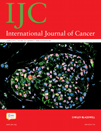Distinct tumor protein p53 mutants in breast cancer subgroups
Abstract
Tumor protein p53 (TP53) is mutated in approximately 30% of breast cancers, but this frequency fluctuates widely between subclasses. We investigated the p53 mutation status in 572 breast tumors, classified into luminal, basal and molecular apocrine subgroups. As expected, the lowest mutation frequency was observed in luminal (26%), and the highest in basal (88%) tumors. Luminal tumors showed significantly higher frequency of substitutions (82 vs. 65%), notably A/T to G/C transitions (31 vs. 15%), whereas molecular apocrine and basal tumors presented much higher frequencies of complex mutations (deletions/insertions) (36 and 33%, respectively, vs. 18%). Accordingly, missense mutations were significantly more frequent in luminal tumors (75 vs. 54%), whereas basal tumors displayed significantly increased rates of TP53 truncations (43 vs. 25%), resulting in loss of function and/or expression. Interestingly, as basal tumors, molecular apocrine tumors presented with a high rate of complex mutations, but paradoxically, these were not associated with increased frequency of p53 truncation. As in luminal tumors, this could reflect a selective pressure for p53 gain of function, possibly through P63/P73 inactivation. Collectively, these observations point not only to different mechanisms of TP53 alterations, but also to different functional consequences in the different breast cancer subtypes.
Abstract
What's new?
TP53 is mutated in approximately 30% of breast cancers, but this frequency fluctuates widely between tumor subclasses. The authors investigated p53 mutations in breast tumors from the luminal, basal, and molecular apocrine molecular subgroups. They found that subgroups differ not only in TP53 mutation frequency but also in mutation types and consequences. They detected a high prevalence of missense mutations in luminal tumors and truncating mutations in basal tumors. In apocrine molecular tumors, despite high prevalence of insertions/deletions, p53 truncation was not increased. The observations point to different mutational mechanisms, functional consequences, and/or selective pressures in different breast cancers subtypes.




